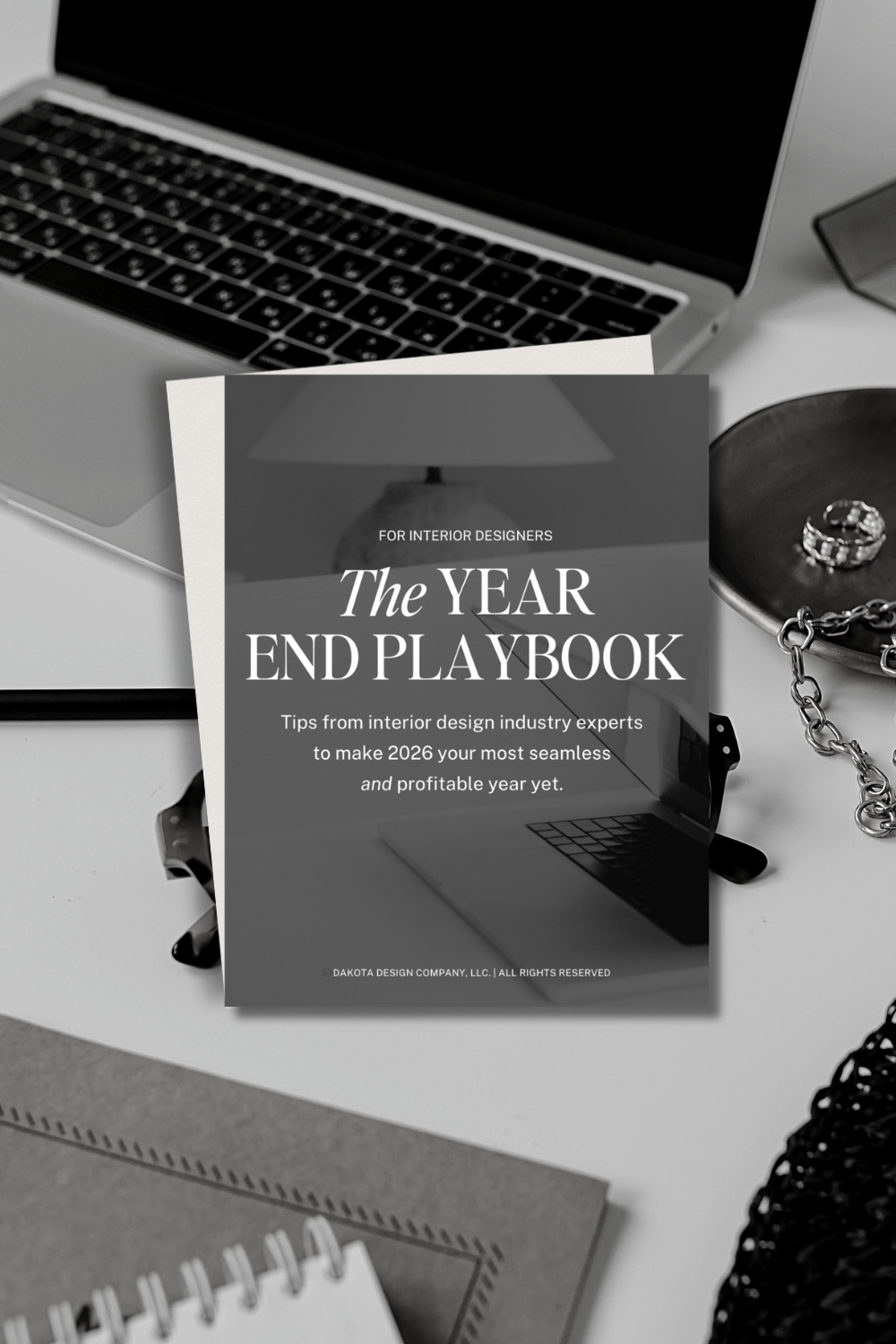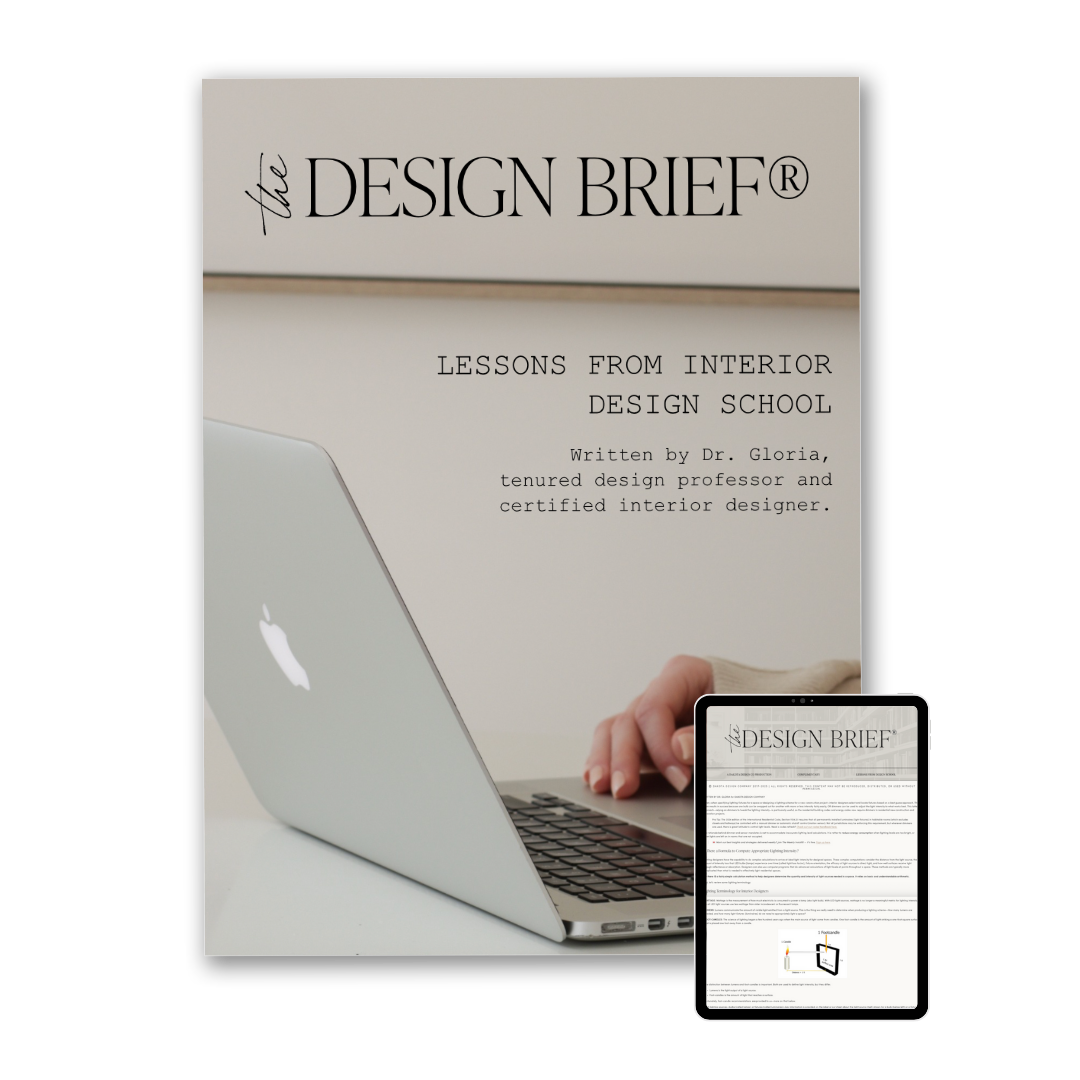
TRUSTED BY INTERIOR DESIGNERS ACROSS THE GLOBE
the Resource Library
Smart strategies, proven methods, and my go-to tools for a streamlined design business.
From pricing to processes, these resources help interior designers run a smoother, more profitable business. Grab free guides, trainings, and the exact tools I recommend to designers to keep their projects (and profits) on track.
NEW RESOURCE FOR INTERIOR DESIGNERS
A free collection of insights from trusted industry experts on pricing, tariffs, marketing, branding, legal, and operations based on what they’re seeing across design businesses right now.
Includes a special 20% savings on templates and trainings in The Design Library and The Workroom.
Shifts Designers Can’t Ignore
FREE TRAINING for INTERIOR DESIGNERS
Stand Out & Get Press
Ever pitched a project to a magazine and heard 🦗🦗🦗?
Same.
Let's change that.
I teamed up with Alex from The PR Collaborative to bring you a complimentary masterclass on how to stand out to editors in 2025 and finally get your projects published.
You'll learn:
✔️ How to find a story in every project
✔️ How to format pitches editors actually read
✔️ What to include (and leave out)
✔️ What editors are looking for right now
Walk away with strategies you can use immediately!
COMPLIMENTARY RESOURCES FOR INTERIOR DESIGNERS
Stay Sharp with Real-World Design Knowledge
Sign up for The Design Brief®, our free, twice-monthly resource. Each issue breaks down the technical and construction-focused topics being taught in design programs today so you can hone your craft and avoid falling behind.
Download my complimentary Luxury Client Experience Blueprint to design (or refine) your interior design process, from initial inquiry to onboarding all the way through to the final goodbye and request for feedback.
Create a Signature Process for your Interior Design Business
How to Use Asana in your Interior Design Business
Download my complimentary Asana Blueprint to learn how to set up the free version of Asana so you can run your interior design business and client projects in a more seamless, organized way.
Get The Weekly Install®, my complimentary newsletter that helps 19,000+ interior designers build profitable and sustainable businesses based on my experience working with 100+ design firms.
Expert Business Insights and Advice for Interior Designers

COMPLIMENTARY QUIZ FOR INTERIOR DESIGNERS
You don’t need to overhaul everything. You just need to fix the right thing.
This 2-minute quiz will help you identify what’s holding you back and how to fix it.

The Designed to Scale® Method is my signature three-month, group coaching and consulting program/system that helps interior designers refine and price their services, set boundaries, and create an elevated process so they can charge more and work less. This is the same framework I’ve used with 100+ private clients and hundreds of students. And it’s the same one our students use to make better decisions for their business at every turn.
⏳ Get on the waitlist for early access + special bonuses.
NEW EDITION DROPS ON FRIDAY
A free, no-fluff digital publication for interior designers (and the business coaches who support them). Get expert insights, proven strategies, and real-world advice straight from my experience working privately with 100+ design firms. Practical, profitable, and right to your inbox every Friday.
FREE FLODESK TRAINING ⬇ FOR INTERIOR DESIGNERS
|
FREE FLODESK TRAINING ⬇ FOR INTERIOR DESIGNERS |
DAKOTA DESIGN CO X FLODESK
Email marketing doesn’t have to feel overwhelming or like another to-do on your already full plate.
In this free training, I’ll walk you through how to easily set up and serve your audience using my favorite email service provider: Flodesk. Whether you’re new to email marketing or need a streamlined system, this free workshop will help you:
✔️ Create an email capture form to start building your list
✔️ Design a high-converting landing page (without tech headaches)
✔️ Set up automated emails that nurture your audience while you sleep
If you’ve been waiting for the right time to start email marketing, this is it.
Watch the free training and start growing your list today.
Free Email Marketing Workshop for Interior Designers

PLUG & PLAY TEMPLATES FOR INTERIOR DESIGNERS
Shop The Design Library
My done-for-you, tried-and-true business resources, client experience templates, and standard operating procedures for interior designers. Used by designers just starting out all the way to over $4MM/year in revenue. What took me years to develop, refine, and test inside 100+ design firms can be yours in minutes.
Couldn’t Run My Business without These Tools:
HoneyBook
CLIENT RELATIONSHIP MANAGEMENT
If you're anything like me, you appreciate tools that simplify your life, not complicate it. That's why HoneyBook is my go-to for managing contracts, automating client emails, scheduling appointments, sending invoices, and keeping track of leads. You can set up workflows, create client questionnaires, and schedule meetings all in one place for your whole team to see.
Because I’m a HoneyBook Educator, you can save on your first year when you sign up through my unique link.
Asana
FOR PROJECT MANAGEMENT
As a Certified Asana Partner, I can tell you this: Asana is a game-changer for staying on top of everything. It’s the best tool for managing tasks, projects, and teams—whether you’re running your business solo or leading a team. And, it’s how I run my entire business, life, and remote team.
If you're tired of dropping the ball or missing deadlines, Asana will help keep you organized. Download our free Asana Blueprint here.
Zapier
(rhymes with happier)
If you’re tired of juggling apps and doing repetitive tasks, Zapier is the solution to keep things running behind the scenes so you don’t have to. It connects all your favorite tools and automates the busy work. Whether you’re syncing data or automating processes, Zapier takes care of the heavy lifting.
With both free and paid plans, it’s a tool that’s worth the investment. Trust me!
You’ll wonder how you ever lived without it.
Flodesk
FOR EMAIL MARKETING
Flodesk is the easiest way to create beautiful, polished emails (and it’s how I send, no joke, 17,000+ emails every week in less than an hour).
Whether you’re sending lead magnets or keeping your clients up to date on what’s going on at your interior design studio, Flodesk helps you stay professional without the headache.
Want to see how it works? Watch my free training here and then use my link to save on your subscription.
Loom
FOR VIDEO MESSAGING
“Let’s have another meeting.” Said no one, ever.
Loom saves you hundreds of hours of meetings by allowing you to send quick, personalized video messages instead of scheduling endless calls or in-person appointments.
Scale your impact while still providing a high-touch, personal experience for your clients and streamline your entire behind-the-scenes operations.
Gusto
FOR PAYROLL & HR
Gusto takes the headache out of payroll, benefits, and HR management. Whether you have a team of one or fifty, Gusto handles all the nitty-gritty details, from payroll processing to compliance and reporting. It’s simple to use and makes managing your team’s benefits and taxes a breeze. Plus, with a dedicated support team, you’ll have peace of mind knowing you’re taken care of.
If you want to keep your business running smoothly while focusing on what you do best, Gusto is a must-have. And, please make sure you’re paying yourself.
* I am an affiliate for some of the software listed above and may receive a small commission at no cost to you if you sign up through my links. I only recommend software I use and love in my business and in my clients’ businesses.

Want me in your ear when you're facing a challenge?
What would Katie do? If you’ve ever asked yourself that, you’re not alone. Our clients say it all the time.
And now? You don’t have to wonder.
I’ve built my business, and helped hundreds of interior designers build theirs, by focusing on the one thing that changes everything: the client experience.
I’ve shared my philosophy with top industry leaders, and now, I’m sharing it with you. Choose a podcast episode below, press play, and get the proven strategies to move your business forward.
MOST Popular EPISODES
DAKOTA DESIGN CO X LUANN NIGARA
6 Business Practices of the Most Successful Interior Designers
When you’ve worked behind the scenes of over a hundred interior design firms like my team and I have, you start to see the patterns.
I joined LuAnn Nigara for a second time on her Power Talk Friday series on A Well-Designed Business® (the #1 podcast in the interior design industry) to share the six key business practices that set the most successful firms apart.
If you’ve ever wondered what the industry’s top designers are doing differently, this episode lays it all out.
DAKOTA DESIGN CO X LUANN NIGARA
The Client Experience Starts with Processes
This episode? A game-changer for interior designers who listened to it.
LuAnn Nigara and I unpack what it really takes to elevate your client experience without running yourself ragged trying to be everything to everyone. Because caring deeply about your clients shouldn’t mean stretching yourself too thin. The key? Your processes.
On the podcast, we break down:
✔️ The ROI of a well-designed client experience (yes, it’s measurable)
✔️ Why streamlined systems don’t make you robotic—they make you irreplaceable
✔️ How a clear, intentional process builds trust, credibility, and profitability
This Top 5 Podcast Episode of 2021 struck a chord for a reason: designers who applied these strategies saw happier clients, stronger boundaries, and higher profits.
What Does Your Interior Design Business Need?
DAKOTA DESIGN CO X MORE TIME TO DESIGN
I sat down with Beth Bieske, Australian interior designer, software developer, and business coach to talk about the real challenges designers are facing in 2024, plus the strategies that actually work.
In this episode, we chat about:
The challenges designers are facing in 2024
How to attract better leads without relying solely on social media
Pricing with confidence
How new designers should structure their services
Creating real connections in an AI-driven world
If you’re looking for insight, clarity, and a fresh perspective on what’s working right now, this conversation is for you.
DAKOTA DESIGN CO X DESI CRESWELL
Systems Myths Debunked: Mindset & Strategy for Designers
What’s holding you back from actually implementing systems? If you think it’s time, team buy-in, or perfectionism—think again.
In this episode, I team up with Desi Creswell, business and life coach for interior designers, to tackle the biggest myths that keep designers stuck in the cycle of overwhelm. Desi takes on the mindset piece, while I break down the logistics so you can move forward with clarity and confidence.
We cover:
✔️ How to get your team and contractors on board with change
✔️ Where to start fixing your processes (even when everything feels like a hot mess)
✔️ What to consume (and ignore) when perfectionism is keeping you paralyzed
If you’ve been spinning your wheels trying to streamline your business, this is the episode you need.
DAKOTA DESIGN CO X WINGNUT SOCIAL
Why Interior Designers Need Systems & Processes
A luxury client experience doesn’t just happen. It’s built from the inside out.
On this episode of the Wingnut Social Podcast, I break down why systems and processes aren’t just an operational task; they’re the foundation of a high-end, seamless client experience. We dive into the behind-the-scenes work that makes your business run like a well-oiled machine so your clients feel cared for at every step.
If you’ve been relying on instinct, memory, or sheer willpower to manage your projects, this episode will change the way you work.
DAKOTA DESIGN CO X DESIGN BIZ SURVIVAL GUIDE
Recession Strategies for your Design Business with Design Biz Survival Guide
When the economy shifts, will your interior design business be ready, or reactive?
In this episode of Design Biz Survival Guide, I sit down with Rick Campos to share three powerful strategies to protect your design business in times of economic uncertainty. We go beyond the usual advice and dive into practical, proven ways to safeguard your revenue without sacrificing creativity.
We cover:
✔️ How to control expenses without cutting what matters most
✔️ Why diversifying revenue streams is the key to stability
✔️ Smart marketing strategies to stay competitive even in a crowded market
If you want your business to thrive in any economy, this episode is a must-listen.

THE DTS FILES | PREMIUM BUSINESS INSIGHTS AND ADVICE FOR INTERIOR DESIGNERS
The DTS Files: Private Library of Business Insights & Advice for Interior Designers
Inside The DTS Files, you’ll get premium, no-fluff content that goes beyond surface-level advice, offering real strategies, tested inside 100+ design firms.
From pricing and client experience to process refinement and scaling, this is where you’ll find the insights to streamline your workflow, attract better clients, increase your profits, and be more intentional with your next move.
If you’ve ever wished for a private vault of expert insights to fine-tune your design business, this is it.
**When you make a purchase from The Design Library or The Workroom, you’ll get your first year free ($150 value)!

WHEN I’M NOT WRITING, I’M READING
You’ll most often find me reading psychological thrillers and historical fiction novels but I try to read one business book a month with a goal of 52 total books a year. So yes, there is ALWAYS a stack of books on my nightstand. So many books … so little time! These are just a few of my favorites.
The Gift of Fear
by Gavin de Becker
The Pumpkin Plan
by Mike Michalowicz
Giftology
by John Ruhlin
Profit First
by Mike Michalowicz
The Push
by Ashley Auddrain
The Nightingale
by Kristin Hannah
The Women
by Kristin Hannah
The Ghost Writer
by Alessandra Torre
Lessons in Chemistry
by Bonnie Garmus

























